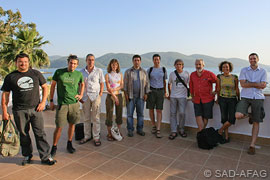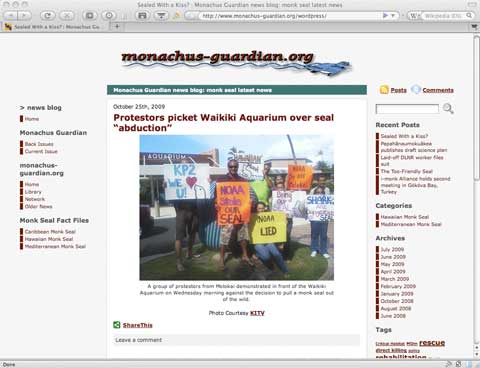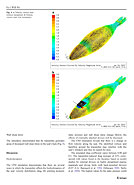

 |
||
 |
||
Vol. 12 (2): November 2009 |
||
Quebec workshop establishes Med-Pacific links, but will action ever follow?
Some 50 scientists and researchers from different corners of the world met in Quebec, Canada, on 10 October 2009 to attend a workshop on Hawaiian and Mediterranean monk seals. While workshops themselves have never been in particularly short supply where monk seals are concerned, this one showed some distinction from the rest in attempting to forge closer working ties between managers and researchers working in both widely-separated domains of the genus, the Hawaiian archipelago, and the Mediterranean and Atlantic. In the organisational lead-up to the workshop, there was also a palpable sense among some that such measures were long overdue, given increasing anxiety over the fate of the two species and the threats they face. The Hawaiian monk seal, declining by 4% per year, is posing massive challenges to managers and scientists, both in the NWHI and the Main Hawaiian Islands. For the first time, those involved in protection of the species, be that in habitat protection or in public outreach, are beginning to realise that the fate of Monachus schauinslandi may well be determined on their watch. Likewise in the Mediterranean, where despite important strides in conservation in several countries, monk seal conservation is still beset by chronic lack of funding, limited public outreach, and a poor track record both in establishing and managing protected areas. Despite some PR-driven articles in the popular press apparently masquerading as journalism, managers are also facing local hostility to protection measures in several marine protected areas. The workshop, “Research, Management Conservation, and Policy in Monk Seal Recovery: A Global Perspective”, was held as an adjunct to the 18th biennial World Marine Mammal Science Conference. Prior to attending the meeting, Kit Kovacs, chair of IUCN Pinniped Specialist Group, expressed the hope that the Workshop would “develop working plans to address the problems faced by these two species.” IUCN and its PSG is under pressure to demonstrate forward movement in the conservation of the Mediterranean monk seal, particularly after the IUCN General Assembly voted overwhelmingly in favour of a resolution calling for “urgent action” on behalf of the species in October 2008. Measures detailed in the resolution included efforts to extend and improve the management of protected areas, while facilitating collaborative conservation projects with the assistance of the PSG and the Species Survival Commission [see IUCN resolution calls for monk seal action, TMG 11(2): 2008 and IUCN World Congress votes overwhelmingly for monk seal action, TMG 12(1): June 2009]. In recent press statements announcing the publication of a Red List assessment of endangered European mammals, IUCN again reiterated that its “IUCN World Conservation Congress, held in Barcelona last October, called for international action to preserve their [monk seal] natural habitats.” Those concerns were echoed by the PSG in Quebec, with a presentation stating that as part of a 2008 IUCN reassessment of the status of the world’s land and marine mammals the Group had concluded “that the conservation status of monk seals had not improved between 1996 and 2008.” It went on to note that: “1) Caribbean monk seals were extinct; 2) Mediterranean monk seals remain critically endangered and current demographic trends do not indicate recovery; for the few populations from which information is available, numbers suggest either stabilization or decline; and 3) the condition of the Hawaiian monk seal has deteriorated, and because of their continued decline in numbers, they have now been listed as critically endangered.” The PSG concluded by saying that: “Serious and effective conservation actions are needed if monk seals are to persist in the future.” The PSG is now said to be considering expanding Mediterranean monk seal representation within the Group to take in specialists working practically on monk seal conservation issues in the field, both in the Mediterranean and the Atlantic. As has so often been the case with conference resolutions and action plans focusing on the monk seal however, it remains to be seen what, if any, practical measures will actually see the light of day. Watch this space. Posters presented during the workshop are listed in our Recent Publications section, and are available for download. Workshop conclusions and recommendations will be published here, when available.
|
 |
|
 |
|
|
i-monk Alliance participants at Gököva Bay. |
The International Monk Seal Conservation Alliance (known by its abbreviation, i-monk) held its second regular meeting in Gököva Bay, Turkey on 11-12 June 2009. Gököva Bay is the site of an integrated coastal zone management plan being implemented by i-monk Alliance member SAD-AFAG in association with Turkey’s Environment Protection Agency for Special Areas (EPASA).
Formally established last year, the i-monk Alliance aims to strengthen ties between monk seal conservation and research projects from the Eastern Mediterranean to the Atlantic, developing common strategies in conservation policy and operational protocols [see International Alliance takes shape in Madeira, TMG 11 (2): November 2008]. Founding and current members are CBD-Habitat (Fundación para la Conservación de la Biodiversidad y su Hábitat) of Spain, IFAW (International Fund for Animal Welfare), MOm (The Hellenic Society for the Study and Protection of the Monk Seal) of Greece, The Monachus Guardian (an international journal and website dedicated to monk seals and their threatened habitats), the Parque Natural da Madeira of Portugal, and SAD-AFAG (Underwater Research Society / Mediterranean Seal Research Group) of Turkey.
The Gököva Bay meeting ended with participants agreeing a range of measures to enhance international coordination, design common operational protocols, develop joint projects, and improve public outreach and lobbying.
Several measures were subsequently enacted during the summer, including the launch of an embryonic website at www.i-monk.org, as well as an internet forum, allowing Alliance members to communicate, debate and exchange documents on a range of scientific and policy issues.
On the policy front, the Alliance has recently released a common statement on the translocation and reintroduction of Mediterranean monk seals, delineating the scientific conditions under which such actions might be considered warranted. The statement was released publicly for the first time in October, at the World Marine Mammal Science Conference monk seal workshop in Quebec [see related news item, above].
i-monk Alliance. 2009. Common statement on a possible translocation/ reintroduction plan for the Mediterranean monk seal. International Monk Seal Conservation Alliance: 1-2. [PDF  150KB]
150KB]

Thanks to the support of the Government of the Balearic Islands, the November 2008 issue of The Monachus Guardian has now been published in Spanish.
If you have Spanish-language friends or colleagues who you think might be interested in the publication, please let them know.
The Spanish translation can be accessed at www.monachus-guardian.org/spanish or through the TMG portal www.monachus-guardian.org.
For those few who missed the announcement in our last issue, The Monachus Guardian is now also publishing a news blog, specifically designed to deliver breaking news updates between the summer and winter issues of the journal.

Those using news reader software may also subscribe to the blog’s RSS feed.
If you have monk seal-related news, images or video you would like to submit for publication, please contact the .
We take the opportunity of alerting our readers to the following publications on marine biodiversity and broader conservation issues.

Temple, H.J. and A. Cuttelod. (Compilers). 2009. The Status and Distribution of Mediterranean Mammals. IUCN, Gland, Switzerland and Cambridge, UK: 1-32. [PDF  2.7 MB]
2.7 MB]
“The latest assessment of Mediterranean mammals shows that one in six is threatened with extinction at a regional level, according to the IUCN Red List of Threatened Species.
The study, which assesses the status of 320 mammals in the region, except whales and dolphins, finds three percent are Critically Endangered, five percent are Endangered and eight percent are Vulnerable.
The Mediterranean Monk Seal (Monachus monachus) and the Iberian Lynx (Lynx pardinus) are both Critically Endangered. The IUCN World Conservation Congress, held in Barcelona last October, called for international action to preserve their natural habitats.”

Hazekamp, A.A.H., R. Mayer and N. Osinga. 2009. Flow simulation along a seal: the impact of an external device. European Journal of Wildlife Research Published online: 30 June 2009. doi:10.1007/s10344-009-0293-0. [Abstract]
Of potential interest to monk seal rehabilitation and research programmes in the Mediterranean and Hawaii, this publication claims to demonstrate measurable impacts on a seal’s swimming ability when fitted with back-mounted devices such as satellite transmitters and bio-logging tags: “The results of this study demonstrate that external devices can change the hydrodynamics of the seal, which is expected to alter the seal’s physiology and behaviour and its use of the ecosystem. Long-term attachment may have adverse effects on the animal’s welfare.”
EndQuoteToxic chemicals leaching from sea-dumped plastics Scientists have identified a new source of chemical pollution released by the huge amounts of plastic rubbish found floating in the oceans of the world. A study has found that as plastics break down in the sea they release potentially toxic substances not found in nature and which could affect the growth and development of marine organisms. Until now it was thought that plastic rubbish is relatively stable chemically and, apart from being unsightly, its principle threat to living creatures came from its ability to choke or strangle any animals that either got caught in it or ingested it thinking it was food. But the latest research suggests that plastic is also a source of dissolved substances that can easily become widely dispersed in the marine environment. Many of these chemicals are believed to be toxic to humans and animals, the scientists said. […]
|
 
Copyright © 2009 The Monachus Guardian. All Rights Reserved |